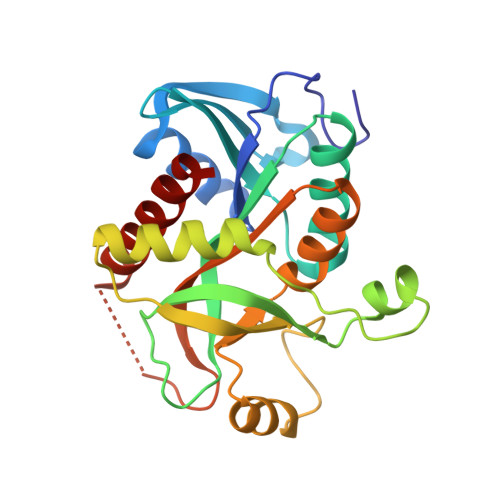Identification of a subversive substrate of Trichomonas vaginalis purine nucleoside phosphorylase and the crystal structure of the enzyme-substrate complex.
Zang, Y., Wang, W.H., Wu, S.W., Ealick, S.E., Wang, C.C.(2005) J Biol Chem 280: 22318-22325
- PubMed: 15817485
- DOI: https://doi.org/10.1074/jbc.M501843200
- Primary Citation of Related Structures:
1Z33, 1Z34, 1Z35, 1Z36, 1Z37, 1Z38, 1Z39 - PubMed Abstract:
Trichomonas vaginalis is an anaerobic protozoan parasite that causes trichomoniasis, a common sexually transmitted disease with worldwide impact. One of the pivotal enzymes in its purine salvage pathway, purine nucleoside phosphorylase (PNP), shows physical properties and substrate specificities similar to those of the high molecular mass bacterial PNPs but differing from those of human PNP. While carrying out studies to identify inhibitors of T. vaginalis PNP (TvPNP), we discovered that the nontoxic nucleoside analogue 2-fluoro-2'-deoxyadenosine (F-dAdo) is a "subversive substrate." Phosphorolysis by TvPNP of F-dAdo, which is not a substrate for human PNP, releases highly cytotoxic 2-fluoroadenine (F-Ade). In vitro studies showed that both F-dAdo and F-Ade exert strong inhibition of T. vaginalis growth with estimated IC(50) values of 106 and 84 nm, respectively, suggesting that F-dAdo might be useful as a potential chemotherapeutic agent against T. vaginalis. To understand the basis of TvPNP specificity, the structures of TvPNP complexed with F-dAdo, 2-fluoroadenosine, formycin A, adenosine, inosine, or 2'-deoxyinosine were determined by x-ray crystallography with resolutions ranging from 2.4 to 2.9 A. These studies showed that the quaternary structure, monomer fold, and active site are similar to those of Escherichia coli PNP. The principal active site difference is at Thr-156, which is alanine in E. coli PNP. In the complex of TvPNP with F-dAdo, Thr-156 causes the purine base to tilt and shift by 0.5 A as compared with the binding scheme of F-dAdo in E. coli PNP. The structures of the TvPNP complexes suggest opportunities for further improved subversive substrates beyond F-dAdo.
Organizational Affiliation:
Department of Chemistry and Chemical Biology, Cornell University, Ithaca, NY 14853-1301, USA.















